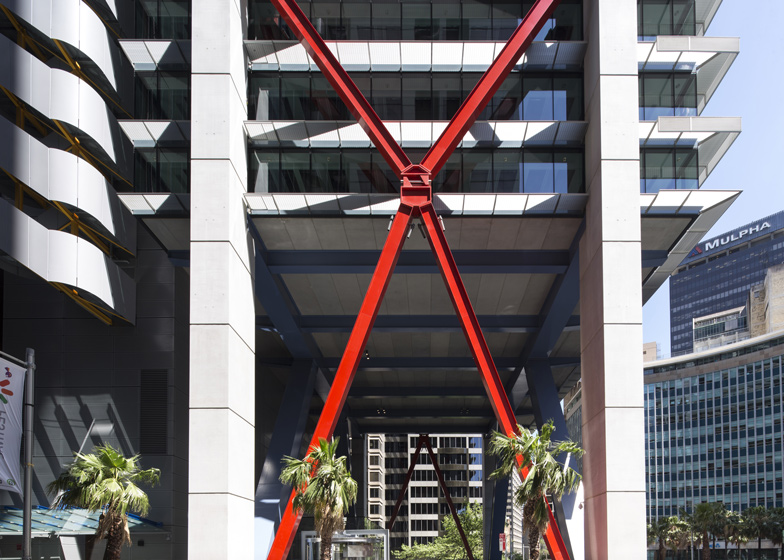Architects Rogers Stirk Harbour + Partners and Lippmann Partnership have completed a 34-storey office tower in Sydney with criss-crossing red braces on its sides and an elevated terrace cutting through its middle.
Rogers Stirk Harbour + Partners collaborated with Sydney office Lippmann Partnership to design the tower for Australian real estate company Mirvac.
Located on Hunter Street in Sydney's Central Business District, 8 Chifley comprises a pair of glass volumes that are separated by a triple-height private terrace on the eighteenth floor.
The structural framework extends to the exterior of the building. Red steel beams brace the walls on the sides of the tower, plus larger members offer support where there are gaps in the floor plates.
A five-storey-high void at the base of the tower creates a lofty public plaza leading to the entrance, while a landscaped roof offers another accessible outdoor space.
Spaces inside the building are divided into seven zones, each comprising a stack of three floors. There are openings between levels in these clusters, intended to encourage interaction amongst employees.
"[8 Chifley's] emphasis on community, both indoors and out, from ground to roof, celebrates Australia's passion for a balanced quality of life and the great outdoors," said architect Ivan Harbour.
"The building finally forms a focus to Chifley Square, drawing the public plaza up to its front door and forming a great loggia for all Sydney-siders to enjoy," he added.
Photography is by Brett Boardman.
Here's more information from Rogers Stirk Harbour + Partners:
8 Chifley
8 Chifley is the Sydney Central Business District's newest and most progressive commercial tower from Mirvac.
Dramatically different to anything seen before on the Sydney skyline, this 34-storey office building, is the product of a global collaboration between the internationally renowned UK architectural practice Rogers Stirk Harbour + Partners and Australia's Lippmann Partnership.
It is the first completed building in Australia featuring the distinctive design philosophy of Rogers Stirk Harbour + Partners but remains a project very much of its place. The distinctive red bracing on the exterior of the building reveals the structural skeleton of 8 Chifley, combining structural efficiency, elegance, and most importantly highly functional space planning.
The building is made up of two stacked modules of 12 and nine floors, with seven 'villages' of three-storey communal workspaces, providing connectivity and vertical integration between the floors which create the feeling of extensive space. Central to the building's sense of community is the elevated 'village square' on the 18th floor, set within a three-storey void. This area will provide a focal point for occupants of the building, allowing meeting and interaction within a light and airy space.
The building has been designed to make the most of its prominent, north-facing site, bounded by Elizabeth, Hunter and Phillip Streets. Its highly transparent façade, high ceilings and legible structure ensure the building enjoys open and unobstructed views out over the city and a sense of space and light within.
Perhaps the defining feature of the project is the six-storey open space at street level that not only forms a grand entrance to the building, but creates a new, significant area of public space which addresses and completes Chifley Square. The open space is repeated midway up the building and again at the top, integrating Australia's outdoor lifestyle into the city's work environment.
8 Chifley is also one of the greenest buildings in Sydney, it has achieved a 6 Star Green Star Office Design v2 certified rating representing "world leadership" in environmentally sustainable design and is committed to achieving a 5 Star NABERS Energy Rating. The design, is very specific to the climate and culture of Sydney. The result is a beautiful piece of architecture that enhances the public realm while providing occupants with wonderful internal spaces within which to develop working communities.

